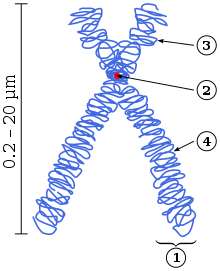This article needs additional citations for verification. (April 2018) |


A chromatid (Greek khrōmat- 'color' + -id) is one half of a duplicated chromosome. Before replication, one chromosome is composed of one DNA molecule. In replication, the DNA molecule is copied, and the two molecules are known as chromatids.[1] During the later stages of cell division these chromatids separate longitudinally to become individual chromosomes.[2]
Chromatid pairs are normally genetically identical, and said to be homozygous. However, if mutations occur, they will present slight differences, in which case they are heterozygous. The pairing of chromatids should not be confused with the ploidy of an organism, which is the number of homologous versions of a chromosome.
- ^ "What is a Chromatid?". About.com. Archived from the original on 3 December 2010. Retrieved 18 July 2017.
- ^ "Definition of CHROMATID". Merriam-Webster. Retrieved 18 July 2017.